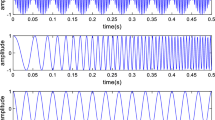Abstract
A novel joint diagonalization (DOA) matrix method is proposed to estimate the two-dimensional (2-D) DOAs of uncorrelated narrowband signals. The method constructs three subarrays by exploiting the special structure of the array, thereby obtaining the 2-D DOAs of the array based on joint diagonalization directly with neither peak search nor pair matching. The new method can handle sources with common 1-D angles. Simulation results show the effectiveness of the method.
Similar content being viewed by others
References
Chan A Y J, Litva J. MUSIC and maximum likelihood techniques on two-dimensional DOA estimation with uniform circular array. IEE P-Radar Son Nav, 1995, 3(142): 105–114
Kedia V S, Chandna B. A new algorithm for 2-D DOA estimation. Signal Process, 1997, 60(3): 325–332
van der Veen A J, Ober P B, Deprettere E F. Azimuth and elevation computation in high resolution DOA estimation. IEEE Trans Signal Process, 1992, 7(40): 1828–1832
Yin Q Y, Zou L H, Newcomb R. A high resolution approach to 2-D signal parameter estimation—DOA matrix method, J China Inst Commun (in Chinese), 1991, 4(12): 1–6
Yin Q Y, Newcomb R, Zou L. Estimating 2-D angle of arrival via two parallel linear arrays. In: Proceedings of IEEE International Conference on Acoustic, Speech and Signal Processing. Glasgow: IEEE, 1989. 2803–2806
Yin Q Y. High resolution direction of arrival estimation. Doctor dissertation (in Chinese). Xi’an: Xi’an Jiao Tong University, 1989
Jin L, Yin Q Y. Space-time DOA matrix method. Acta Electron Sin (in Chinese), 2000, 7(28): 8–12
Jin L, Yin Q Y. Analysis and generalization of space-time DOA matrix method. Acta Electron Sin (in Chinese), 2001, 3(39): 300–303
Zoltowski M D, Haardt M, Mathews C P. Closed-form 2-D angle estimation with rectangular arrays in element space or beamspace via unitary ESPRIT. IEEE Trans Signal Process, 1996, 2(44): 316–322
Si D, Le Q, Shen S, Zhou Y. Closed-form 2-D angle estimation via 2-D unitary ESPRIT with uniform centro-symmetric array. Acta Electron Sin (in Chinese), 1999, 3(27): 67–70
Belouchrani A, Abed-Meraim K, Cardoso J F, et al. A blind source separation technique using second-order statistics. IEEE Trans Signal Process, 1997, 2(45): 434–444
Roy R, Kailath T. ESPRIT—estimation of signal parameters via rotational invariance techniques. IEEE Trans Acoust Speech Signal Process, 1989, 7(37): 984–995
Marcos S, Marsal A, Benidir M. The propagator method for source bearing estimation. Signal Process, 1995, (42): 121–138
Author information
Authors and Affiliations
Corresponding author
Additional information
Supported by the National Natural Science Foundation of China (Grant No. 60372022) and Program for New Century Excellent Talents in University (Grand No. NCET-05-0806)
Rights and permissions
About this article
Cite this article
Xia, T., Wang, X., Zheng, Y. et al. Joint diagonalization DOA matrix method. Sci. China Ser. F-Inf. Sci. 51, 1340–1348 (2008). https://doi.org/10.1007/s11432-008-0096-z
Received:
Accepted:
Published:
Issue Date:
DOI: https://doi.org/10.1007/s11432-008-0096-z




